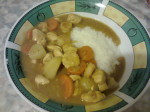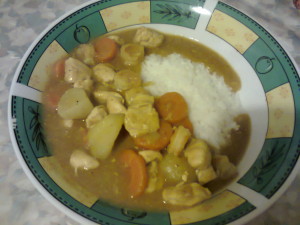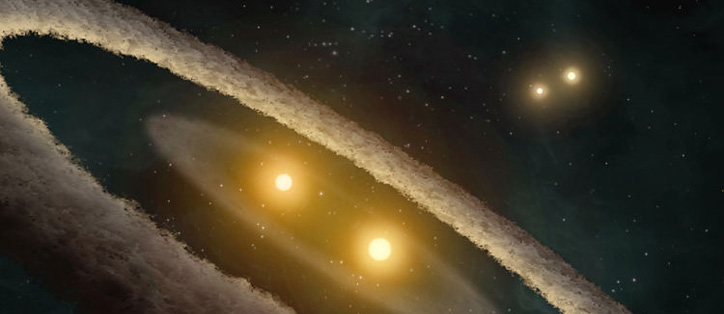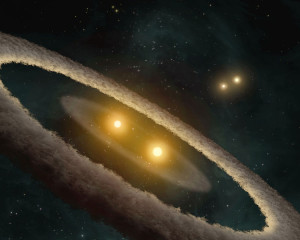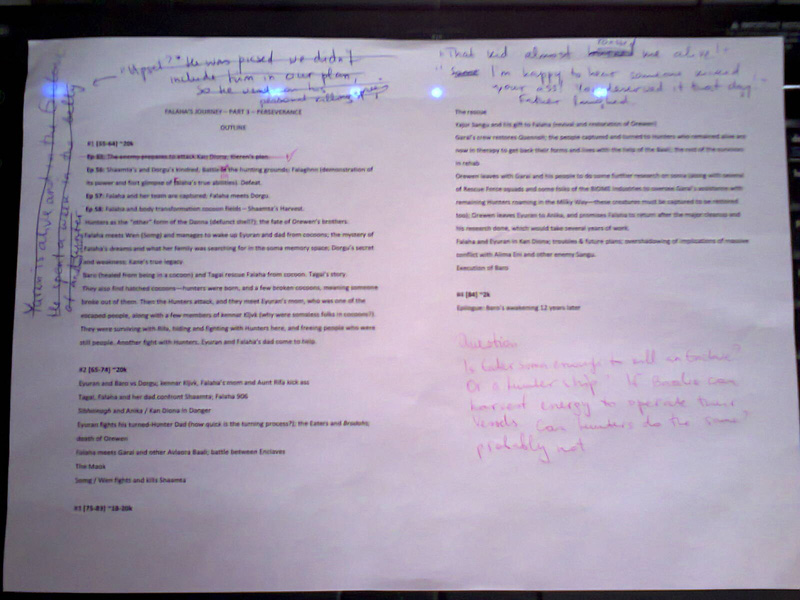I love to eat. To be more specific, I love to eat curry rice. I also love to cook, just not too often. 😉 My first attempt at making this curry was a failure, since I didn’t mix the roux well enough. But the second attempt was golden and it also allowed me to polish the recipe. The godly taste forever engraved into my brain and sometimes it haunts me in my dreams, making me drool! 😀
Today I am going to share my recipe with you, boys and girls. So you, too, will become addicted to curry and have disturbing dreams, craving that soft yet unforgettable taste!
/cue maniac laughter/
Now, let’s get to work!
Things you'll need: butter, oil (olive, canola, whatever), flour, curry powder, pepper powders (black, cayenne or ghost), tomato paste/sauce, worcestershire sauce, onion, garlic, chicken, shrimp, carrots, potatoes, salt, water. A large pot for curry (4L is fine), a small sauce pan for roux.
Roux:
-
3 tablespoons butter
1/4 cup (4 tbsp) flour
2 tablespoons curry powder
1/5 tablespoon kayenne pepper powder
1/5 tablespoon black pepper powder
1 tablespoon tomato sauce
1 tablespoon worcestershire sauce
Tips: Heat levels depend on types of pepper powder used. To add some nuclear power, experment with the amounts of kayenne (ghost pepper, etc) & black pepper, say, make ½ tbsp each.
In a small saucepan, melt the butter over medium low heat. When the butter is completely melted, add the flour. Stir to combine the butter and flour. Soon the butter and flour fuse and swell. Do not stop stirring because the roux will easily burn. After the roux will turn to light brown color (usually takes 5-10 mins for me), add the curry powder, kayenne pepper, black pepper, tomato paste and worcestershire. Cook and stir for 30 seconds and remove from the heat.
Curry:
-
2 teaspoons (or 1 tbsp) oil
1 white onion, peeled and sliced in quarters
2 garlic cloves, sliced long ways
800 g chicken, cut into chunks
400 g tiger shrimp, peeled and whole
4 cups water
2 medium to big carrots, sliced into round chunks
2 big potatoes (or up to 6 small depending on size), peeled and sliced into square chunks
2 teaspoons salt
1 teaspoon curry powder
In a large pot, heat up oil. Add sliced onion and garlic. Saute for about 20 minutes on medium low, stirring constantly. Do not cook any of this with high heat. The onions and garlic will burn really easy. Slow and low is the key. Once garlic is golden brown, add chicken and stir until all chicken is white on each side. Add water and bring to a boil over medium high. Add carrots, potatoes, shrimps, salt and curry powder. Cover and simmer for 15 minutes on medium low, stirring occasionally.
Tip: Cooking rice will take 15-20 mins. So start cooking it while you let your curry simmer.
Once potatoes are soft enough to cut with ease, it’s time to add the roux. Reduce heat to low. Take some broth from the curry and add it into the roux, stirring until it is all liquid. Pour the mix back into the curry boil, stirring constantly until all the roux has been added. Keep stirring until all the roux has dissolved, leaving a thick, dark yellow curry mix. Remove from heat and let sit for 5 minutes. Serve with rice.
#Bon appétit !
